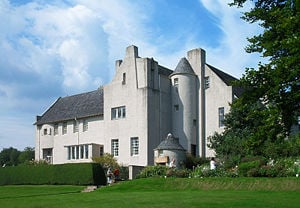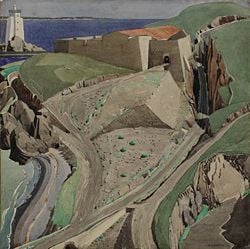Charles Rennie Mackintosh
- For the chemist and inventor, see Charles Mackintosh.
Charles Rennie Mackintosh (June 7, 1868 – December 10, 1928) was a Scottish architect, designer, and watercolourist who was a designer in the Arts and Crafts movement and also the main exponent of Art Nouveau in Scotland.
Life
Born in Glasgow, and suffering from a bad foot and eye problems, he was free to discover and draw sketches of a great deal of the Scottish countryside as a child. He attended the former Allan Glen's School[1]. At the age of 16 he was apprenticed to an architect named John Hutchison, where he worked from 1884 until 1889. Also during that time he became a draughtsman with Honeyman and Keppie, a new architectural practice, eventually becoming a partner in 1901. All along he attended evening classes in art at the Glasgow School of Art. It was at these classes that he first met Margaret MacDonald (whom he later married), her sister Frances MacDonald, and Herbert MacNair who was also a fellow apprentice with Mackintosh at Honeyman and Keppie. The group of artists, known as "The Four," exhibited in Glasgow, London and Vienna, and these exhibitions helped establish Mackintosh's reputation. The so-called "Glasgow" style was exhibited in Europe and influenced the Viennese Art Nouveau movement known as Sezessionstil (in English, The Secession) around 1900.
He joined a firm of architects in 1889 and developed his own style: a contrast between strong right angles and floral-inspired decorative motifs with subtle curves, e.g. the Mackintosh Rose motif, along with some references to traditional Scottish architecture. The project that helped make his international reputation was the Glasgow School of Art (1897-1909).
He died in 1928 of throat cancer.
Architectural Work
In the UK
Amongst his noted architectural works are:
- Windyhill, Kilmacolm
- Hill House, Helensburgh (National Trust for Scotland)
- House for an Art Lover, Glasgow
- The Mackintosh House (interior design, reconstructed with original furniture and fitments at the Hunterian Museum and Art Gallery, Glasgow)
- Queen's Cross Church, Glasgow
- Ruchill Church Hall, Glasgow
- Holy Trinity Church, Bridge of Allan, Stirling
- Scotland Street School, Glasgow, now Scotland Street School Museum.
- The Willow Tearooms, Sauchiehall Street, Glasgow; one of Miss Cranston's Tearooms: see Catherine Cranston for his interior design work on her other tea rooms
- Hous'hill, interior design of the home of Catherine Cranston and her husband John Cochrane (demolished, furniture in collections)
- Glasgow School of Art, Glasgow
- Craigie Hall, Glasgow
- Martyrs' Public School, Glasgow
- The Royal Highland Fusiliers Museum, Glasgow
- Former Daily Record offices, Glasgow
- Former Glasgow Herald offices in Mitchell Street, now The Lighthouse - Scotland's Centre for Architecture, Design and the City
- 78 Derngate, Northampton (interior design for Wenman Joseph Bassett-Lowke, founder of Bassett-Lowke)
- 5 The Drive, Northampton (for Bassett-Lowke's brother-in-law)
Unbuilt Mackintosh
Although moderately popular (for a period) in his native Scotland, most of his more ambitious designs were not built. His designs of various buildings for the 1901 Glasgow International Exhibition were not constructed, as was his "Haus eines Kunstfreundes" (Art Lover's House) in the same year. He competed in the 1903 design competition for Liverpool Cathedral, but lost the commission to Giles Gilbert Scott.
Although the House for An Art Lover was subsequently (1989-1996) built after his death, Mackintosh left many unbuilt designs.
- Railway Terminus,
- Concert Hall,
- Alternative Concert Hall,
- Bar and Dining Room,
- Exhibition Hall
- Science and Art Museum
- Chapter House
- Liverpool Cathedral - Anglican Cathedral competition entry
Although Mackintosh's architectural output was fairly small he had a considerable influence on European design. Especially popular in Austria and Germany, Mackintosh's work was highly acclaimed when it was shown at the Vienna Secession Exhibition in 1900. It was also exhibited in Budapest, Munich, Dresden, Venice and Moscow.
Design work and paintings
Mackintosh also worked in interior design, furniture, textiles and, metalwork. Much of this work combines Mackintosh's own designs with those of his wife, whose flowing, floral style complimented his more formal, rectilinear work. Like his contemporary Frank Lloyd Wright, Mackintosh's architectural designs often included extensive specifications for the detailing, decoration, and furnishing of his buildings. His work was shown at the Vienna Secession Exhibition in 1900.
Later in life, disillusioned with architecture, Mackintosh worked largely as a watercolourist, painting numerous landscapes and flower studies (often in collaboration with Margaret, with whose style Mackintosh's own gradually converged) in the Suffolk village of Walberswick (to which the pair moved in 1914). By 1923, he had entirely abandoned architecture and design and moved to the south of France with Margaret where he concentrated on watercolour painting. He was interested in the relationships between man-made and naturally occurring landscapes. Many of his paintings depict Port Vendres, a small port near the Spanish border, and the nearby landscapes.
Retrospect
Mackintosh's designs gained in popularity in the decades following his death. His House for an Art Lover was finally built in Glasgow's Bellahouston Park in 1996, and the University of Glasgow (which owns the majority of his watercolour work) rebuilt a terraced house Mackintosh had designed, and furnished it with his and Margaret's work (it is part of the University's Hunterian Museum). The Glasgow School of Art building (now renamed "The Mackintosh Building") is regularly cited by architectural critics as among the very finest buildings in the UK. The Charles Rennie Mackintosh Society tries to encourage a greater awareness of the work of Mackintosh as an important architect, artist and designer.
ReferencesISBN links support NWE through referral fees
- Davidson, Fiona (1998). The Pitkin Guide: Charles Rennie Mackintosh. Great Britain: Pitkin Unichrome. ISBN 0-85372-874-7.
- Fiell, Charlotte and Peter (1995). Charles Rennie Mackintosh. Taschen. ISBN 3-8228-3204-9.
See also
- Glasgow
- Culture in Glasgow
Further reading
- Alan Crawford Charles Rennie Mackintosh (Thames & Hudson)
- John McKean Charles Rennie Mackintosh, Architect, Artist, Icon (Lomond) illustrated by Colin Baxter
- David Brett Charles Rennie Mackintosh: The Poetics of Workmanship (1992)
- Timothy Neat Part Seen Part Imagined (1994)
- John McKean Charles Rennie Mackintosh Pocket Guide
External links
- Charles Rennie Mackintosh Society Glasgow, Scotland]
- Mackintosh Online Searchable online catalogue with over 1000 images - the world's largest collection of Mackintosh works from the Hunterian Museum and Art Gallery, University of Glasgow, Scotland.
- Unbuilt Mackintosh Models and Designs
- Charles Rennie Mackintosh - Glasgow Buildings
- Charles Rennie Mackintosh Pictorial History
- Charles Rennie Mackintosh Chronology
- Charles Rennie Mackintosh at the archINFORM database
Credits
New World Encyclopedia writers and editors rewrote and completed the Wikipedia article in accordance with New World Encyclopedia standards. This article abides by terms of the Creative Commons CC-by-sa 3.0 License (CC-by-sa), which may be used and disseminated with proper attribution. Credit is due under the terms of this license that can reference both the New World Encyclopedia contributors and the selfless volunteer contributors of the Wikimedia Foundation. To cite this article click here for a list of acceptable citing formats.The history of earlier contributions by wikipedians is accessible to researchers here:
The history of this article since it was imported to New World Encyclopedia:
Note: Some restrictions may apply to use of individual images which are separately licensed.






